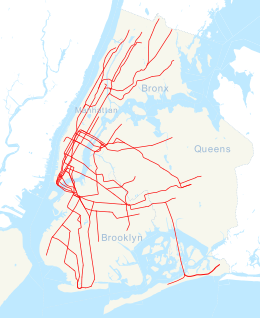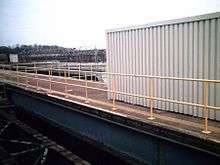Atlantic Avenue station (BMT Canarsie Line)
Atlantic Avenue is a rapid transit station on the BMT Canarsie Line, a part of the New York City Subway system. Located at the intersection of Atlantic and Snediker Avenues at the borders of Ocean Hill, Brownsville, and East New York, Brooklyn, it is served by the L train at all times.
Atlantic Avenue | |||||||
|---|---|---|---|---|---|---|---|
| Station statistics | |||||||
| Address | Atlantic Avenue & Snediker Avenue Brooklyn, NY 11207 | ||||||
| Borough | Brooklyn | ||||||
| Locale | Ocean Hill, Brownsville, East New York | ||||||
| Coordinates | 40.675724°N 73.902969°W | ||||||
| Division | B (BMT) | ||||||
| Line | BMT Canarsie Line BMT Fulton Street Line (formerly) | ||||||
| Services | L | ||||||
| Transit connections | |||||||
| Structure | Elevated | ||||||
| Platforms | 1 island platform (in service), 1 island platform (abandoned) | ||||||
| Tracks | 2 | ||||||
| Other information | |||||||
| Opened | July 4, 1889[1] (Fulton Street Line) July 28, 1906[2] (Canarsie Line) | ||||||
| Rebuilt | 1916 (Dual Contracts) 2004 (CBTC) | ||||||
| Station code | 133[3] | ||||||
| Opposite-direction transfer available | Yes | ||||||
| Former/other names | Atlantic Avenue – East New York Avenue[4] | ||||||
| Traffic | |||||||
| Passengers (2019) | 469,819[5] | ||||||
| Rank | 411 out of 424[5] | ||||||
| Station succession | |||||||
| Next north | Broadway Junction (Canarsie): L Broadway Junction (Jamaica): no regular service Manhattan Junction (Fulton Street elevated; demolished) | ||||||
| Next south | Sutter Avenue: L Eastern Parkway (Fulton Street elevated; demolished; original) Hinsdale Street (Fulton Street elevated; demolished; replacement) | ||||||
| |||||||
| |||||||
| |||||||
History
Atlantic Avenue opened July 4, 1889 for the BMT Fulton Street Line portion and on July 28, 1906 for the BMT Canarsie Line portion. The Fulton Street Line platforms closed April 26, 1956.[6] It was rebuilt in 1916, and was also reconfigured in 2002–2004. This station is one of the most well-preserved examples of the Dual Contracts architecture, as much of the period woodwork and ironwork is intact. The fare control area was modernized with new lighting and high, rounded windows. The stop lies directly above the Long Island Rail Road's East New York station, which is located in the median of Atlantic Avenue.
Dual Contracts rebuild
| 4 Platform level |
Northbound | ← Fulton Street Line (through service to Jamaica Line) |
| Island platform | ||
| Northbound | ← Canarsie Line | |
| Northbound | ← Fulton Street Line | |
| Island platform | ||
| Bidirectional | ← Fulton Street Line (peak direction) → | |
| Southbound | Fulton Street Line → Canarsie and Fulton Street Lines (through service from Jamaica Line) → | |
| Island platform | ||
| Southbound | → Canarsie Line → | |
| 3 | Mezzanine | |
| 2 | Atlantic Avenue roadway | |
| G | Street level | Exit/entrance |
| B1 | East New York LIRR | |
Rebuilt and reconfigured under Dual Contracts in 1916, this station had three island platforms, with six tracks. The two western island platforms resembled a typical four track express station and the other island platform was a block to the east over Snediker Avenue. The tracks and platforms were as follows west to east, southbound Canarsie line track, island platform, southbound Fulton Street el track, bi-directional Fulton Street express el track, island platform, northbound Fulton Street el track; northbound Canarsie line track, island platform, northbound Fulton Street el to Jamaica line track. The southbound Fulton Street el track could also be used by trains from the Jamaica line bound for the Canarsie line. During the station's service to both the Fulton Street el and Canarsie line, it was in this configuration. The next stop to the west on the Fulton Street Elevated was Manhattan Junction. The next stop to the east was Eastern Parkway, and later Hinsdale Street.
Current layout
| P Platform level |
Trackbed | No service |
| Island platform, not in service | ||
| Trackbed | No service | |
| Westbound | ← (No service: Broadway Junction/Jamaica) | |
| Island platform | ||
| Eastbound | | |
| M | Mezzanine | Fare control, station agent |
| G | Street level | Exit/entrance, stairs to East New York LIRR station |
After the remaining portion of the Fulton Street el was removed in 1956, the Canarsie line continued to use the westernmost track and platform southbound, and the second track from the east and platform (over Snediker Avenue) northbound. The easternmost track was removed, leaving five in place.[7]
The western-most platform is now the only one in service with both tracks in use. The former southbound Fulton el track is now the northbound track, and was connected to the existing Canarsie Line north of Sutter Avenue station in 2003.[7] Connecting the northbound Canarsie line to this track eliminated the sharp curve onto the structure over Snediker Avenue. The center of the three platforms is still there, but is retained only as a storage area. The easternmost platform was closed to train service in September 2003 and has been demolished except for a small portion that remained intact.[8] The other structures relating to that platform, including the last remnants of the Fulton el, as well as the portion of the el over Snediker Avenue were demolished between September 2003 and February 2004.
North of the station, a single track diverges northeast to East New York Yard, two tracks proceed to Broadway Junction, and two others connect to the Jamaica Line. These last two are not used for regular revenue service, and have not been used thus since 1968.
The station was renovated in 2015–2016.
Exits
The station's only exit point is through the mezzanine. Two conjoined stairways lead from opposite ends of the north portion of the mezzanine, meeting in a combined landing before splitting off into two small stairs to the southeast corner of Atlantic Avenue and East New York Avenue.[9] Another stair, leading from the portion of the mezzanine that is underneath the easternmost platform, leads down to the southwest corner of Atlantic and Snediker Avenues.[9]
References
- "The Fulton Street Elevated". Brooklyn Daily Eagle. June 28, 1889. p. 6. Retrieved December 17, 2016 – via Newspapers.com.

- Atlantic Avenue; BMT Canarsie Line (NYCSubway.org)
- "Station Developers' Information". Metropolitan Transportation Authority. Retrieved June 13, 2017.
- "Subway Car Catches Fire" (PDF). The New York Times. July 30, 1946. Retrieved 16 July 2016.
- "Facts and Figures: Annual Subway Ridership 2014–2019". Metropolitan Transportation Authority. 2020. Retrieved May 26, 2020.
- "First Leg of Rockaways Transit Opened at Cost of $10,154,702" (PDF). nytimes.com. The New York Times. April 30, 1956. Retrieved June 29, 2015.
- "Broadway Junction Transportation Study: NYC Department of City Planning Final Report-November 2008" (PDF). nyc.gov. New York City Department of City Planning. November 2008. Archived (PDF) from the original on 2010-06-06. Retrieved 27 October 2015.
- Abandoned BMT Fulton Street Line Platforms (The Subway Nut)
- "MTA Neighborhood Maps: Ocean Hill" (PDF). mta.info. Metropolitan Transportation Authority. 2015. Retrieved 19 July 2015.
External links
| Wikimedia Commons has media related to Atlantic Avenue (BMT Canarsie Line). |



%26groups%3D_05f006498c63409d61726b0b6e3dfa5aeb512a8e.svg)
